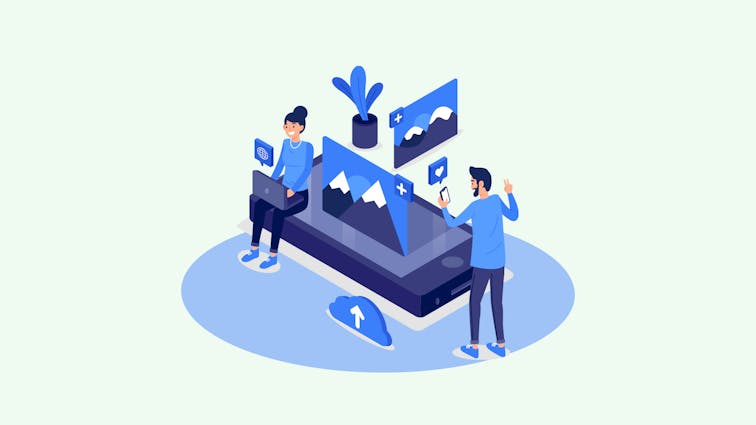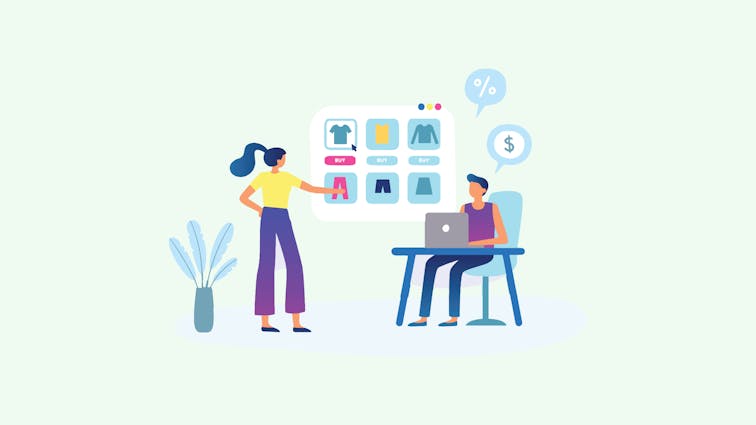
Must-Know Ecommerce Image Optimization Tips for Better Conversions
Are you struggling with slow-loading product images on your ecommerce site?
This common problem can frustrate potential customers, leading to decreased sales and lower site traffic.
Imagine losing a sale just because your images took a few seconds too long to load. Aggravating, isn’t it?
But don’t worry, we’ve got a solution. Our comprehensive guide on ecommerce image optimization is here to help.
Packed with tips and tricks, it’s designed to enhance your site’s performance and user experience.
Properly optimized images are crucial for maintaining visual integrity, especially for ecommerce websites.
92.6% of people consider visual input as the leading factor in their purchase decisions.
Dive in and start optimizing today!
Understanding Image Optimization

Image optimization is a vital process in the digital world, particularly in the realm of eCommerce.
It’s not just about having visually appealing images; it’s about ensuring those images are optimized for speed, performance, and search engine visibility.
Definition of Image Optimization
Image optimization refers to the process of delivering high-quality images in the right format, dimension, size, and resolution while keeping the smallest possible size.
It’s about reducing the file size of your images as much as possible without compromising the quality, to keep your page load times low.
Goals of Image Optimization
The primary goal of image optimization is to speed up your website.
The faster your site loads, the more likely visitors are to stay, improving your bounce rate and potentially your conversion rate.
Another goal is to improve your site’s SEO. Search engines favor websites that load quickly, and images often take up more bandwidth than any other part of a website.
Why Is Image Optimization Important?
Image optimization plays a crucial role in the success of your ecommerce site for several reasons:
- Improved User Experience: High-quality, fast-loading images give customers a seamless browsing and shopping experience.
- Increased Website Speed: Optimized images weigh less, leading to reduced load times and faster site performance.
- Higher Search Engine Rankings: Google and other search engines favor websites with faster loading times, which can result in higher search rankings.
- Better Conversion Rates: A faster site with optimized images leads to a higher probability that visitors will make purchases.
- Reduced Bounce Rates: Slow-loading images can cause potential customers to abandon your site. Optimizing images can reduce bounce rates by retaining user interest.
Key Elements of Image Optimization

When it comes to image optimization, there are several key elements to consider.
These include the image file size and format, the level of image compression, and the dimensions and angles of the image.
Let’s delve into these elements in more detail.
Image File Size and Formats (JPEG vs. PNG vs. WEBP)
The file size and format of an image can significantly impact the speed at which it loads on a webpage.
JPEG, PNG, and WEBP are common image formats, each with its own strengths and weaknesses.
- JPEG: This format is widely used because it offers a good balance between image quality and file size. It’s ideal for photographs and complex images with lots of colors and details.
- PNG: PNGs support transparency and are lossless, meaning they don’t lose quality with compression. They’re ideal for images with text, line drawings, and icons.
- WEBP: This is a modern image format that provides superior lossless and lossy compression. It’s designed to maintain image quality while reducing file size more effectively than JPEG or PNG.
Image Compression Level
Image compression is a crucial aspect of image optimization.
It reduces the file size of an image without degrading the quality of the image below an acceptable level.
The goal is to remove as much unnecessary data as possible to achieve the smallest file size without sacrificing image quality.
There are two types of image compression:
- Lossy: This type of compression removes data from the original file and can significantly reduce file sizes, but at the cost of some loss in quality.
- Lossless: This compression reduces file size without losing any quality. It’s ideal for images that require high levels of detail.
Image Dimensions and Angles
The dimensions of an image refer to its width and height, usually measured in pixels.
Large, high-resolution images can slow down a webpage, so it’s important to resize images to the correct dimensions for your site.
In eCommerce, showing products from different angles can provide a more comprehensive view of the product, helping customers make informed purchasing decisions.
Therefore, it’s crucial to optimize all images, regardless of their angle or perspective.
Practical Tips for Ecommerce Image Optimization

Optimizing images for your eCommerce site can significantly enhance user experience, improve site speed, and boost your SEO rankings. Here are some practical tips to help you optimize your eCommerce images effectively.
1. Using Concise and Direct Image Names
Naming your images descriptively and in plain language can be very beneficial for SEO.
For example, instead of naming an image IMG1234.jpg, name it blue-leather-sofa.jpg.
This allows search engines to understand the content of the image and can help your images appear in relevant search results.
2. Optimizing Alt Attributes
Alt attributes, also known as alt tags, are used to describe the content of images to search engines and users who are unable to view the images.
For example, img src=“blue-leather-sofa.jpg” alt=“Blue leather sofa”.
Make sure to include relevant keywords in your alt attributes to improve your SEO.
3. Choosing Image Dimensions and Product Angles Wisely
Large, high-resolution images can slow down your website. Therefore, it’s important to resize your images to the correct dimensions for your site.
Also, showing products from different angles can provide a more comprehensive view of the product.
For example, you can show a sofa from the front, side, and top angles to give customers a better idea of its shape and size.
4. Resizing Images for Optimal Performance
Resizing your images can significantly reduce their file size, leading to faster page load times.
There are many free online tools available that can help you resize your images without losing quality.
For example, you can use a tool like TinyPNG to reduce the size of your images.
5. Selecting the Right Image Format
Different image formats have different strengths and weaknesses.
JPEGs are generally best for photographs and complex images, PNGs are ideal for images with text or transparency, and WEBP offers superior compression.
For example, if you have a product image with a transparent background, you might choose to save it as a PNG.
6. Optimizing Thumbnails
Thumbnails are smaller versions of images that are often used to preview larger images.
Make sure to optimize your thumbnails just like you would with your regular images to improve page load times.
For example, if your original image is 800x800 pixels, you might create a thumbnail that is 200x200 pixels.
7. Using Image Sitemaps
Image sitemaps provide search engines with additional information about the images available on your website.
This can help your images appear in image search results, potentially driving more traffic to your site.
For example, you can use a tool like Google’s Image Sitemap Generator to create an image sitemap for your site.
By implementing these practical tips, you can effectively optimize your eCommerce images, leading to improved site performance, user experience, and SEO rankings.
Implementing Advanced Optimization Techniques
There are several advanced techniques you can use to further optimize your images:
- Image Compression: Compress your images to reduce file size without sacrificing quality. Aim to keep the image file size below 70-80 KB.
- Browser Caching and Preloading: Use browser caching to speed up page loading times for returning visitors. Preload images to display them faster and boost your Largest Contentful Paint (LCP).
- Fetch priority Attribute: Use the Fetch priority attribute to prioritize loading important images.
- Width and Height Size Attributes: Include width and height size attributes to avoid sudden layout shifts (CLS).
- Image CDN: Use an image Content Delivery Network (CDN) to speed up image delivery.
- Lazy Loading: Enable lazy loading to only load images when they are needed.
- Responsive Images: Use responsive images to ensure images look good on all devices.
By implementing these practical tips, you can effectively optimize your eCommerce images, leading to improved site performance, user experience, and SEO rankings.
Tools for Image Optimization
Optimizing images is crucial for improving the performance and user experience of your website.
Fortunately, there are several tools available that can help you optimize your images efficiently.
Let’s take a look at some popular image optimization tools.
Overview of Popular Image Optimization Tools
- TinyPNG
- ImageOptim
- Kraken.io
- ShortPixel
1. TinyPNG

TinyPNG is a popular online tool that uses smart lossy compression techniques to reduce the file size of your PNG and JPEG images.
It’s incredibly user-friendly; you simply drag and drop your images onto the page, and TinyPNG will compress them.
- Pros: Easy to use, efficient compression, supports both PNG and JPEG.
- Cons: Limited to 20 images at a time for the free version.
2. ImageOptim

ImageOptim is a free application for Mac that allows you to compress images without losing quality. It removes bloated metadata and compresses images.
- Pros: Free, excellent compression, removes unnecessary metadata.
- Cons: Only available for Mac.
3. Kraken.io

Kraken.io is an online image optimization tool that offers both lossless and intelligent lossy optimization. It also provides a WordPress plugin and a robust API.
- Pros: High-quality compression, WordPress plugin available, API for developers.
- Cons: Free version has a file size limit.
4. ShortPixel
![]()
ShortPixel is a WordPress plugin that optimizes images and PDF documents. It offers both lossy and lossless image compression and supports JPG, PNG, GIF, and WebP formats.
- Pros: Easy integration with WordPress, supports multiple formats, also optimizes PDFs.
- Cons: Monthly limits on the number of images you can compress for free.
Conclusion:
In conclusion, optimizing eCommerce images is essential for enhancing your website’s performance, user experience, and SEO rankings. Make use of various tools and advanced optimization techniques to cater to different formats, sizes, and devices.
Remember that investing time and effort in this process can have a positive impact on your website’s success and ultimately result in a higher conversion rate for your online business.
Frequently Asked Questions about Image Optimization for eCommerce
1. How do I optimize my images for eCommerce?
Optimizing images for eCommerce involves several steps:
- Resize Your Images: Large images can slow down your website. Resize your images to the correct dimensions for your site.
- Compress Your Images: Use an image compression tool to reduce the file size of your images without sacrificing quality.
- Choose the Right Format: Different image formats are suited to different types of images. JPEGs are generally best for photographs, while PNGs are better for images with text or transparency.
- Use Descriptive File Names and Alt Tags: These help search engines understand what your image is about, which can improve your SEO.
- Use Interactive Features Wisely: Features like 360-degree views and zoom-in capabilities can enhance the user experience, but they can also slow down your site if not properly optimized.
2. What is image optimization?
Image optimization is the process of delivering high-quality images in the right format, dimension, size, and resolution, while keeping the smallest possible size. It’s about reducing the file size of your images as much as possible without compromising the quality, to keep your page load times low.
3. What image type is best for eCommerce?
The best image type for eCommerce depends on the specific image and its purpose. JPEGs are generally best for photographs and complex images, as they offer a good balance between image quality and file size. PNGs are better for images with text, line drawings, icons, or when transparency is needed. WEBP is a modern format that provides superior compression, but it’s not supported by all browsers.
4. What is image optimization for SEO?
Image optimization for SEO involves making your images search engine friendly through methods like using descriptive file names, adding alt tags, choosing the right format, and compressing your images. Properly optimized images can help your website rank higher in search engine results.
5. How do I optimize image quality?
To optimize image quality:
- Choose the Right Format: Different formats are suited to different types of images. Choose the one that best suits your image.
- Compress Your Images: Use an image compression tool to reduce the file size of your images without sacrificing quality.
- Use High-Resolution Images: Start with a high-resolution image to ensure your image remains clear and sharp even after compression and resizing.
Remember, the goal is to find the right balance between image quality.








